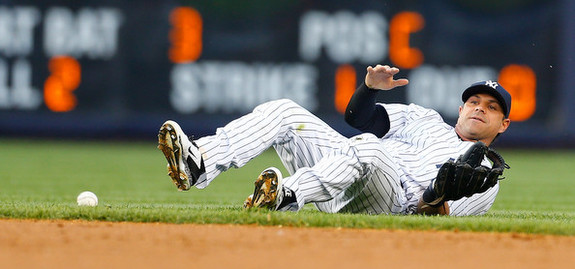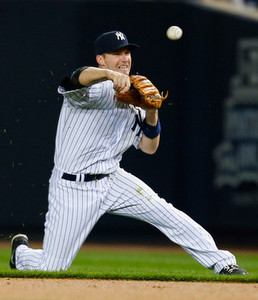
It wasn’t hard to see the bad infield defense coming. Coming into the season, the Yankees’ best infield defender was their first baseman, who was coming off a season lost to wrist surgery. They had a soon-to-be 40-year-old coming off major ankle/leg injuries and a broken down 36-year-old manning the middle infield, and their third baseman was a second baseman by trade. It was a far cry from the 2009 infield, which was arguably the best in baseball history.
To make matters worse, the Yankees built a ground ball pitching staff because Yankee Stadium is tiny and fly balls equal homeruns. Their starters ranked third in the league with a 45.1% ground ball rate this year even though noted ground ballers CC Sabathia and Ivan Nova combined to make only 12 starts. There were plenty of poor throws, booted grounders, and balls that simply scooted by defenders for base hits and extended innings in April and May.
Early in the year, the bad infield defense was the most consistent part of the team. It showed up every night and impacted the game. Derek Jeter and Brian Roberts were predictably poor at shortstop and second base, respectively, and third base was shaky regardless of whether Kelly Johnson or Yangervis Solarte was playing. Mark Teixeira showed considerable rust following the long layoff, compounding the problem. Their best infield gloveman (Brendan Ryan) started the year hurt and was then glued to the bench because he can’t hit.
The Yankees tried — and sorta succeeded, actually — to compensate for their range-challenged infield by employing the infield shift. A lot. Like almost every batter featured a non-traditional infield alignment. Heck, the team acknowledged part of the reason they signed Roberts and Johnson was their familiarity with the shift after playing with the Orioles and Rays (and Blue Jays). Oh sure, there were plenty of balls that beat the shift but that’s inevitable. Here’s a nugget from Ken Davidoff in early-June:
Baseball Info Solutions utilizes the measure “Defensive Runs Saved” then breaks that into two categories: non-shift and shift.
Heading into Wednesday’s action, the Yankees ranked last in the major leagues — 30th out of 30 clubs — in both categories. They had minus-16 runs saved without the shift — in other words, their porous defense was responsible for allowing 16 more runs than the average defense would have allowed given the same balls hit in the same spots.
With the shift, the Yankees were at minus-4 runs saved, an improvement of 12 runs.
“While they have struggled to get outs when shifted relative to the rest of the league, because they are so range challenged it actually makes sense for them to shift aggressively so that they can put their infielders in a position to have to move the least to make a play,” Joe Rosales, a research associate at BIS, wrote in an email. “If they weren’t shifting as much as they have been, things would look even worse.
There is no publicly available shift data (yet), though all throughout the season various reports said the Yankees shifted their infielders as much as any team in baseball aside from the Astros. I don’t think we need any numbers to confirm the Yankees’ infield really stunk defensively when aligned normally and stunk slightly less when shifted against certain batters though. We all watched the games.
The shift wasn’t enough, so Brian Cashman and his staff sought out to improve their infield defense at the midseason because they had to. Roberts and Johnson weren’t hitting or fielding, and Solarte cooled off so much that he was shipped to the minors. If they couldn’t get the offensive helped they needed — there were very few impact bats on the market at the trade deadline — then improving the run prevention was the next best thing.

The infield overhaul started on July 22nd, when the Yankees acquired Chase Headley from the Padres. Right away it was obvious he was a massive, massive, massive upgrade at third. That guy can really pick it. The overhaul continued nine days later, when the team swung deals for Stephen Drew and Martin Prado at the trade deadline. Drew was slated to play second base everyday, but his bat landed eventually him on the bench and put Prado at second on a full-time basis.
Drew is a shortstop by trade and he was playing second base literally for the first time as a professional — he had never play a position other than shortstop in his career, Majors or minors — and there were some growing pains early, but I thought he settled in quite nicely and was an asset in the field later in the season. Prado was primarily a third baseman the last few years, though he had plenty of second base experience and looked natural there when pressed into duty.
Quantifying defense is tough — there are some pretty good stats out there, but they’re far from perfect — so there’s only so much we can do. Here’s how the Yankees’ infield performed on all ground balls before and after the trade deadline, with no adjustment for hit velocity or trajectory or anything fancy like that:
| Games | Ground Balls | NYY BABIP | MLB BABIP | |
|---|---|---|---|---|
| Before Deadline | 107 | 1,279 | .2611 | .2489 |
| After Deadline | 55 | 636 | .2390 | .2590 |
Imperfect analysis but that’s a big improvement! The Yankees went from having the eighth highest BABIP in baseball on ground balls before the trade deadline to having the fifth lowest after July 31st. Simply put, they were turning more ground balls into outs after acquiring Headley, Drew, and Prado.
The revamped infield showed more range and surer hands — Teixeira appeared to shake off the rust as the season progressed as well — after the trade deadline and the numbers back that up. The infield defense went from big problem to … well, let’s call it a smaller problem. I hesitate to call it an asset. Jeter was still an issue at shortstop but there were extenuating circumstances. The Yankees weren’t going to move him off the position with his retirement only weeks away. No chance.
So, the Yankees did the next best thing. They updated the guys playing alongside Jeter at second and third bases, and the improvement was noticeable. The routine plays went back to being routine and every so often a not-so-routine play was made as well. The infield defense was terrible for the first four months of the season and it cost the Yankees games. The help at the trade deadline was a big upgrade but it came too late to help the team make the postseason. The Yankees now have a clean slate (so to speak) at the non-first base infield spots and are able to fill them to above-average defenders this winter.
Leave a Reply
You must be logged in to post a comment.